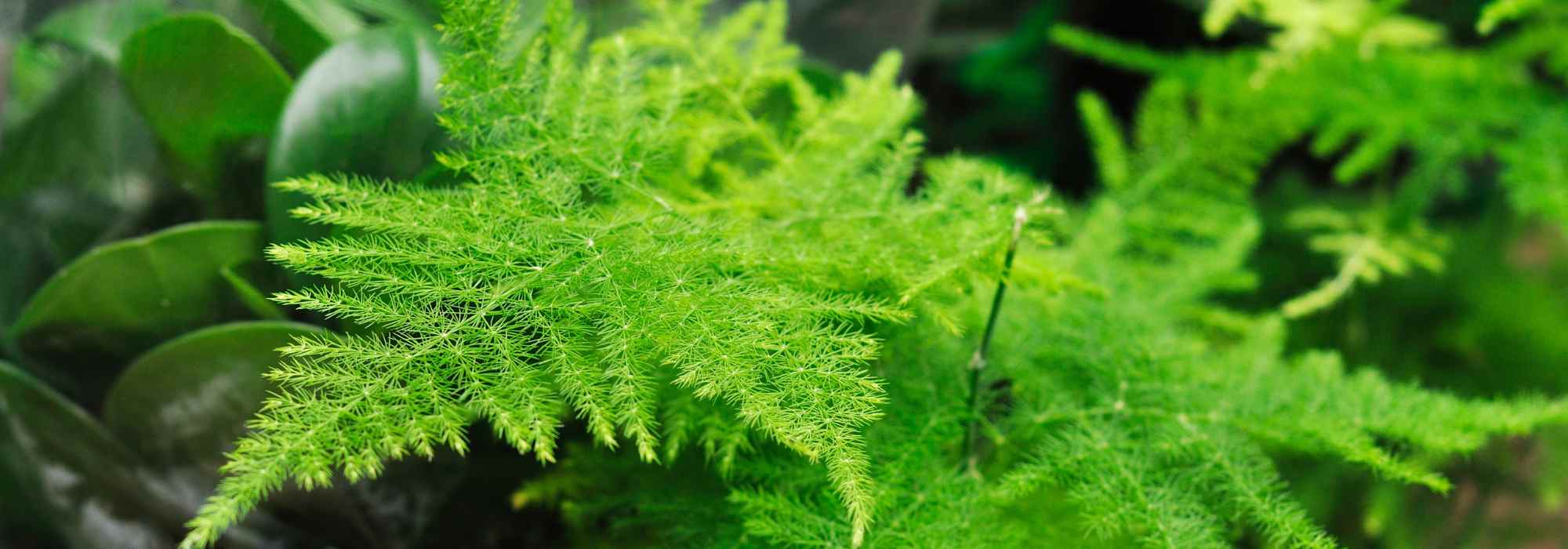
Indoor asparagus : growing and caring for it
Contents
The Asparagus in a nutshell
- The indoor Asparagus is an elegant plant with fine, airy foliage, perfect for brightening up an interior.
- Easy to care for, it thrives in indirect light, well-draining soil, and moderate watering.
- The Asparagus plumosus has an upright, even climbing habit, while the Asparagus sprengeri has a trailing habit, ideal for hanging baskets.
- This plant can be easily propagated by root division in spring.
- The Asparagus adapts to all styles and adds a touch of fresh greenery.
The word from our expert
With its fine and airy foliage, the indoor Asparagus is an ornamental plant as graceful as it is resilient. Belonging to the Asparagaceae family (yes, just like the asparagus in our vegetable gardens!), it is often mistaken for a fern due to its light and airy cladodes (branches capable of photosynthesis). Among the most popular varieties, the Asparagus plumosus charms with its delicate climbing habit, while the Asparagus sprengeri stands out with its long trailing stems, perfect for hanging displays.
Easy to grow, the Asparagus thrives in a light, well-draining substrate and a bright location without direct sunlight. Its care routine includes moderate watering, fertilising in spring and summer, and occasional pruning of dry stems to encourage balanced growth. Quite hardy, it can still fall prey to spider mites or scale insects if the air is too dry. To prevent this, maintaining sufficient humidity and regular misting of the foliage are recommended.
Propagation of the Asparagus is mainly done by dividing clumps, a quick and effective method during repotting in spring. Over time, this plant can become quite large and may require repotting every one to two years. Its tuberous root system allows it to tolerate short periods of drought, making it an excellent choice for beginner gardeners.
In terms of decoration, the Asparagus lends itself to many creative displays: hanging for a cascading effect, in an open terrarium for a jungle vibe, or in a ceramic or terracotta pot for a bohemian or minimalist style. No matter how it’s presented, it brings an unmatched freshness and fits seamlessly into both modern and more natural interiors. Both graphic and airy, it remains a must-have for those seeking an elegant, low-maintenance plant full of character.
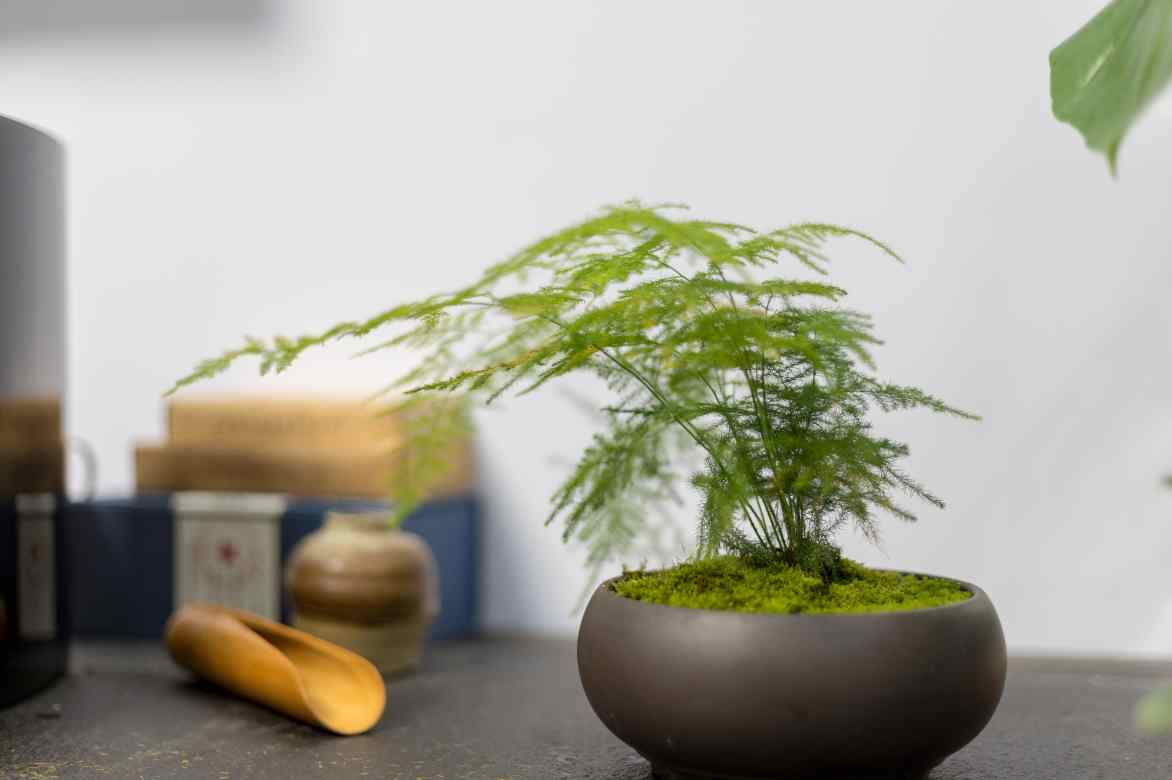
Asparagus plumosus
Botany and description
Botanical data
- Latin name Asparagus sp.
- Family Asparagaceae
- Common name Asparagus, Ornamental Asparagus
- Flowering June to August
- Height 1 m
- Sun exposure bright, no direct sunlight
- Soil type fresh, rich and well-drained.
- Hardiness 5°C maximum
The Asparagus houseplant belongs to the botanical family Asparagaceae, a group of herbaceous and climbing plants that also includes edible species like the garden asparagus (Asparagus officinalis). Its genus name, Asparagus, comes from the ancient Greek “asparagos,” meaning young shoot, referring to the fine, ramified stems characteristic of these plants.
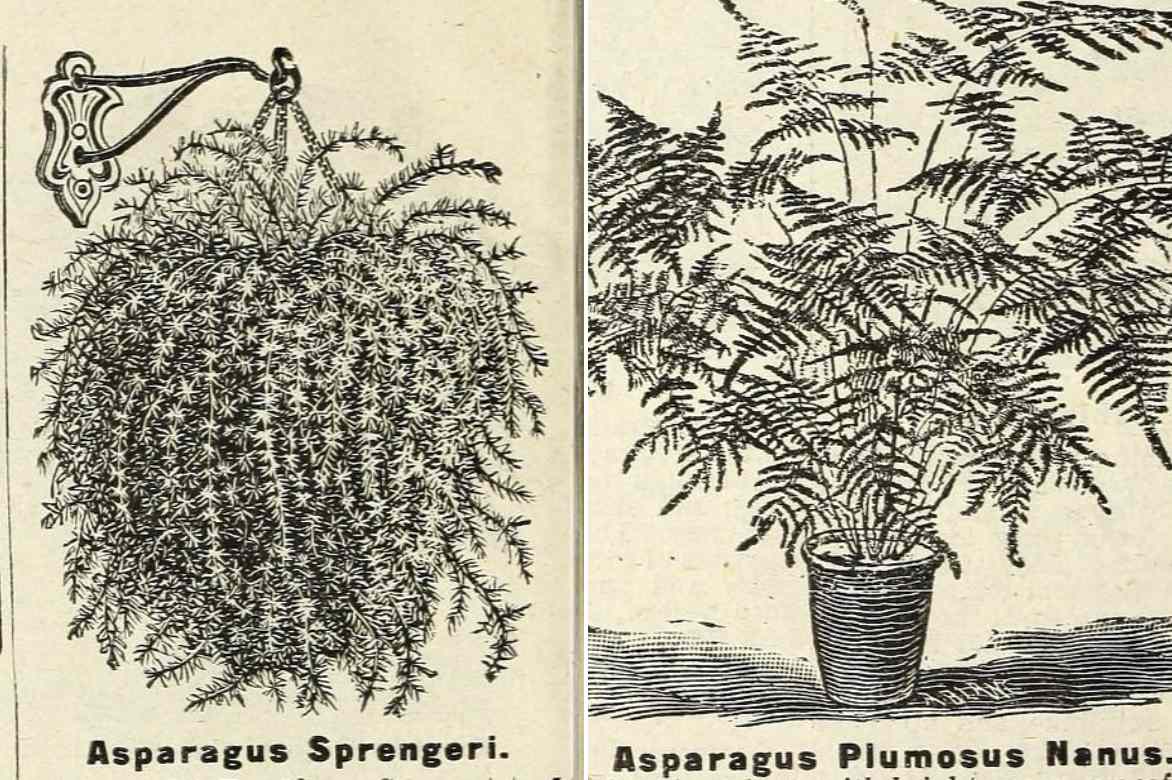
Asparagus illustrations (circa 1920)
In French, the Asparagus is often called indoor asparagus, ornamental asparagus, or even asparagus fern, although it is not a true fern. In its natural habitat, it is mainly found in South Africa and Asia, where it grows as climbing or bushy plants in bright, humid undergrowth. Its fine, airy foliage allows it to efficiently capture the filtered light from the canopy.
Its popularity as a houseplant stems from its light and elegant foliage, reminiscent of the delicacy of ferns, as well as its robustness. It adapts well to domestic conditions, tolerates occasional watering lapses, and thrives in medium light, making it an ideal choice for greenery enthusiasts, even beginners.
Among the most commonly cultivated species, Asparagus plumosus is undoubtedly the most prized for its finely divided, almost feathery foliage, which adds an ethereal touch to any interior. On the other hand, Asparagus sprengeri, sometimes called “florist’s fern,” is more often used in hanging baskets for its trailing habit and rapid growth. Other species like Asparagus densiflorus and Asparagus setaceus are also popular, each offering a unique variation of this light and graceful foliage.
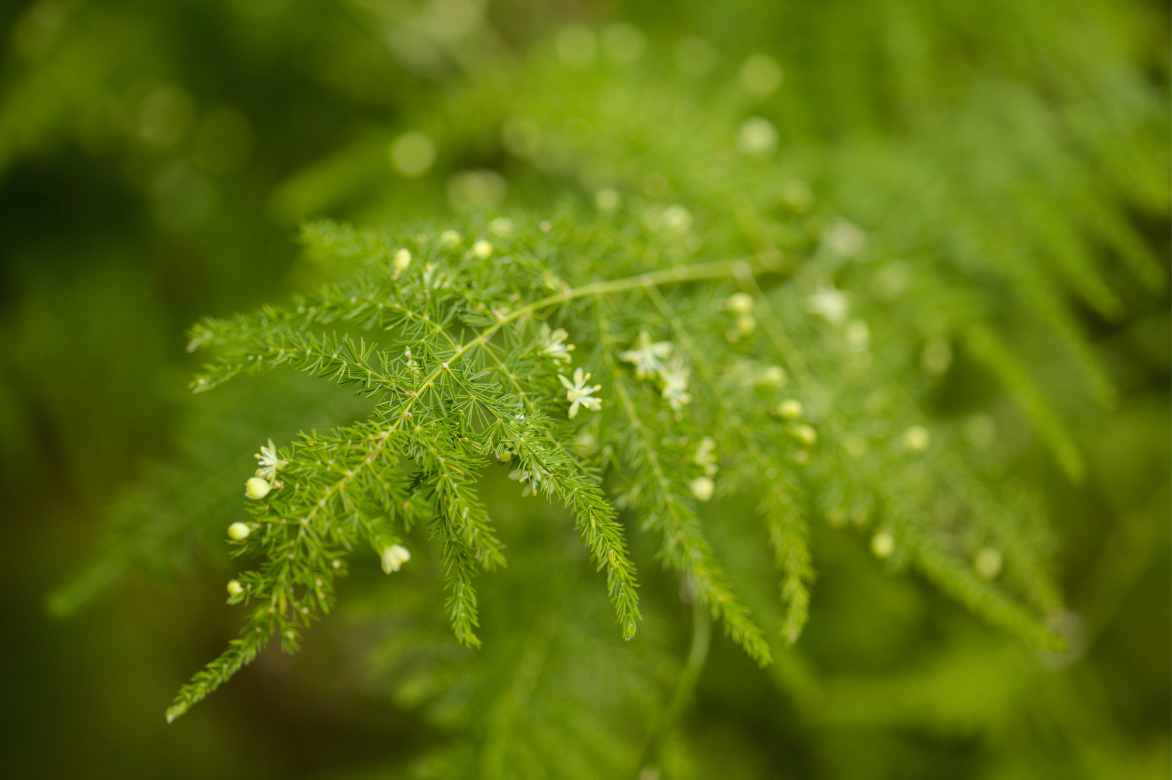
The very discreet flowering of Asparagus setaceus
Asparagus plumosus
The Asparagus plumosus adopts a gracefully upright silhouette when young, but over time, it develops voluble and climbing stems capable of clinging to a support if provided. Its stems, fine and flexible, extend into an airy tangle, giving the plant an ethereal appearance.
At the base, a fleshy and fibrous root system develops in the form of tubercles, allowing it to store water and withstand short periods of drought. Unlike trees or bushes, it does not have a true trunk; its stems emerge directly from the stump and branch abundantly.
The foliage of the Asparagus plumosus is actually made up of cladodes, false needle-like leaves that unfold in thousands, forming a light and airy ensemble. This almost feathery appearance earned it its name. In spring or summer, it may produce tiny white or greenish flowers, very discreet but fragrant, sometimes followed by small spherical berries, green then black at maturity.
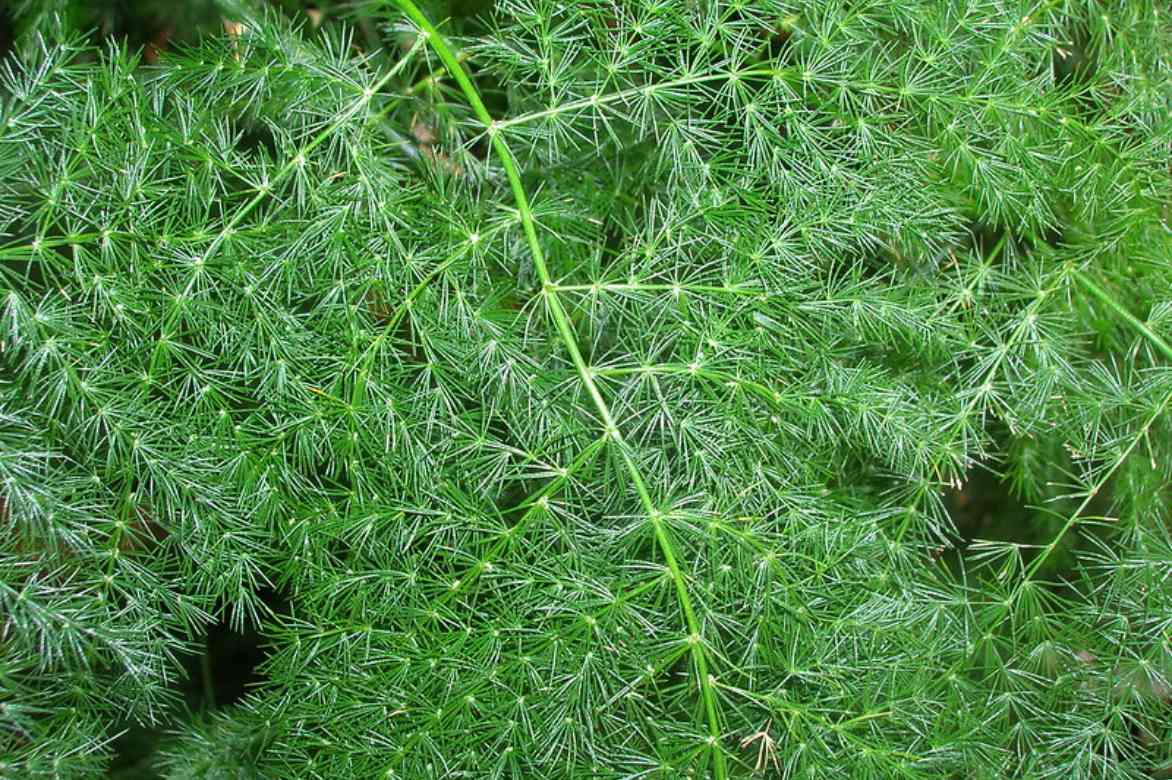
Asparagus plumosus (© Forest and Kim Starr)
Asparagus sprengeri
The Asparagus sprengeri, on the other hand, displays a more arched and trailing habit. Rather than climbing, it develops into soft tufts that cascade elegantly, making it a perfect plant for hanging baskets or pot edges. Its stems are thicker and stiffer than those of the plumosus, though they retain some flexibility.
Again, the fleshy roots allow the plant to survive irregular growing conditions.
Its foliage, though similar to that of the plumosus, is slightly coarser, with slightly more spaced cladodes and a more pronounced bright green hue. When it flowers, it produces small whitish flowers, often followed by bright red berries, adding an extra ornamental touch.
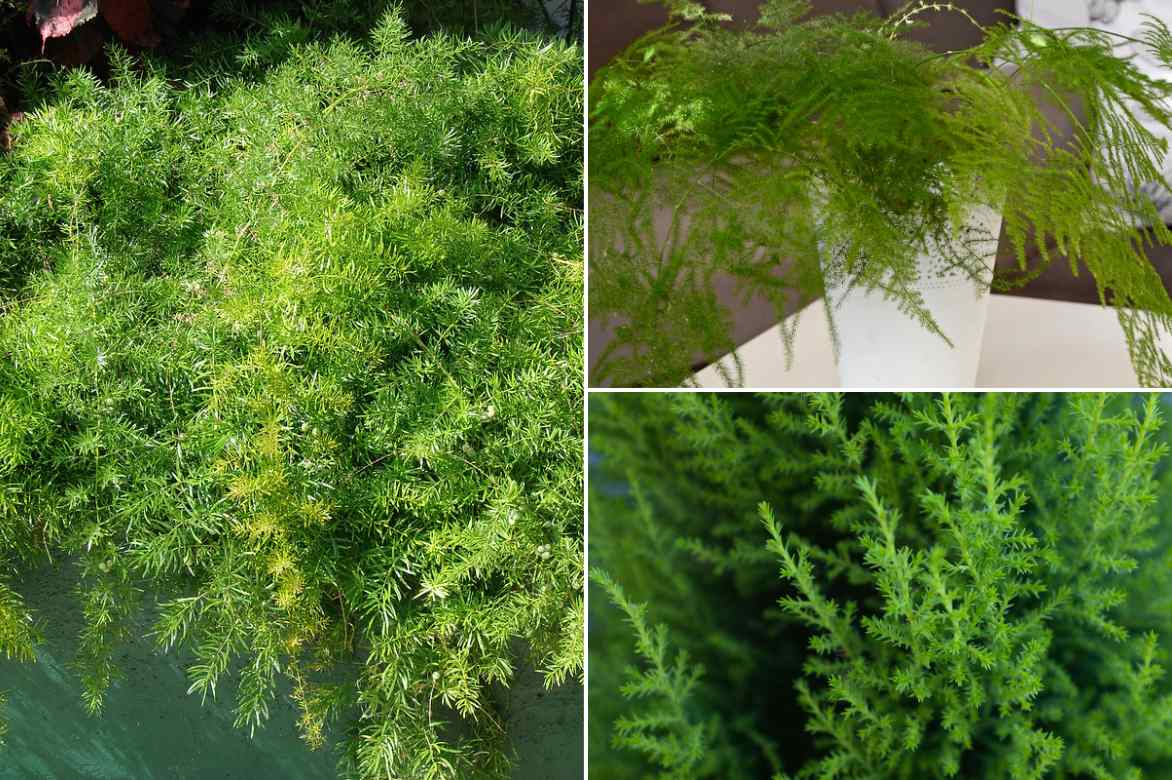
On the left, Asparagus sprengeri (©Forest and Kim Starr). Top right, Asparagus setaceus and bottom right Asparagus densiflorus Myersii
When and how to plant an indoor Asparagus in a pot?
Indoor Asparagus is best planted in spring, the ideal time to allow it to adapt to its new environment and benefit from active growth. However, it can be planted at other times of the year, provided extreme cold or excessive heat is avoided.
The ideal substrate
An Asparagus thrives in a light, well-draining, and slightly humus-bearing substrate. A mixture of houseplant compost, sand, or perlite for drainage, along with a bit of compost or turf to maintain good water retention, is perfect. The goal is to avoid overly compact soil, which could suffocate its tuberous roots.
Where to place it?
Asparagus prefers soft, indirect light, so it appreciates a bright spot without direct sunlight, which could scorch its delicate foliage. An east or west-facing location is ideal, though it tolerates partial shade. It can withstand heated interiors but prefers a temperature between 15 and 25°C, with moderate to high ambient humidity. In overly dry air, its cladodes yellow and drop more easily. To prevent this, regular misting with non-calcareous water or using a humidifier can be beneficial.
Which pot to choose?
Asparagus develops a robust, tuberous root system that can quickly fill its pot. It’s important to choose a wide and deep pot, at least 20 to 25 cm in diameter for a young plant, and opt for a breathable material like terracotta, which helps evaporate excess moisture. A plastic pot also works but retains more water, requiring careful adjustment of watering. Always ensure it has drainage holes to prevent waterlogging.
Steps to plant Asparagus in a pot
- Prepare the pot: place a layer of clay pebbles or gravel at the bottom to improve drainage.
- Fill with substrate: mix your compost with sand or perlite, then pour some into the pot.
- Place the plant: gently remove the Asparagus from its original pot. If the roots are too dense, loosen them slightly with your fingers.
- Position and firm: place the plant in the centre and add substrate around it to cover the roots. Press lightly to stabilise without compacting too much.
- Water moderately: water generously right after planting, then let the compost surface dry slightly before the next watering.
Repotting Asparagus
Asparagus is a fast-growing plant, so it requires repotting every 1 to 2 years, usually in spring. The need for repotting is evident when roots emerge from the drainage holes or growth slows despite good growing conditions. When repotting, follow the same steps as planting, choosing a slightly larger pot (2-3 cm wider in diameter) and refreshing some of the substrate to provide fresh nutrients.
Please note: if the plant becomes too large, this is also an opportunity to divide the stump by carefully cutting sections of tuberous roots, each with a few stems, to create multiple plants.
Culture and Care of Asparagus
The indoor Asparagus is a robust and easy-going plant, but regular care will help it maintain its beautiful, airy foliage and vitality.
Watering: finding the right balance
The Asparagus prefers a slightly moist but never waterlogged substrate. Its tuberous root system allows it to store water, making it tolerant of occasional missed waterings.
- In spring and summer, during active growth, water approximately once or twice a week, allowing the surface of the compost to dry out between waterings.
- In autumn and winter, reduce the frequency to once every 10 to 15 days, as the plant enters dormancy and consumes less water.
The watering water should be non-calcareous and at room temperature, ideally rainwater or filtered water. Avoid stagnant water in the saucer at all costs, as it promotes root rot.
Fertilisation: giving growth a boost
A nutrient supply helps the Asparagus maintain dense, lush green foliage.
- From March to September, add a liquid fertiliser for green plants every 2 to 3 weeks.
- In winter, fertilisation can be stopped or reduced to once a month if the plant continues to grow slightly.
If your Asparagus turns yellow despite proper watering, a lack of nutrients may be the cause. In this case, more regular fertilisation or repotting with fresh substrate can restore its vigour.
Pruning: is it necessary?
The Asparagus does not require strict pruning, but a little maintenance will keep it looking harmonious.
- Cut dry or yellowed stems at the base to encourage the emergence of new shoots.
- To limit its growth or restore a more compact shape, you can cut back some stems in spring. The plant tolerates pruning well and will quickly regrow.
- For climbing varieties like Asparagus plumosus, you can guide the stems onto a support or shorten them if they become too invasive.
Precautions and points to watch
- Beware of overly dry air: the Asparagus does not tolerate very dry environments, especially in winter with heating. Regular misting or a humidifier will help it maintain lush foliage.
- Avoid direct sunlight: too much exposure can cause burns on the cladodes.
- Watch out for cold drafts: it dislikes temperatures below 10°C.
- Handle with care: some varieties, like Asparagus sprengeri, have tiny thorns on their stems, which can irritate the skin.
→ Also read: Indoor Asparagus Fern: How to Care for It Season by Season
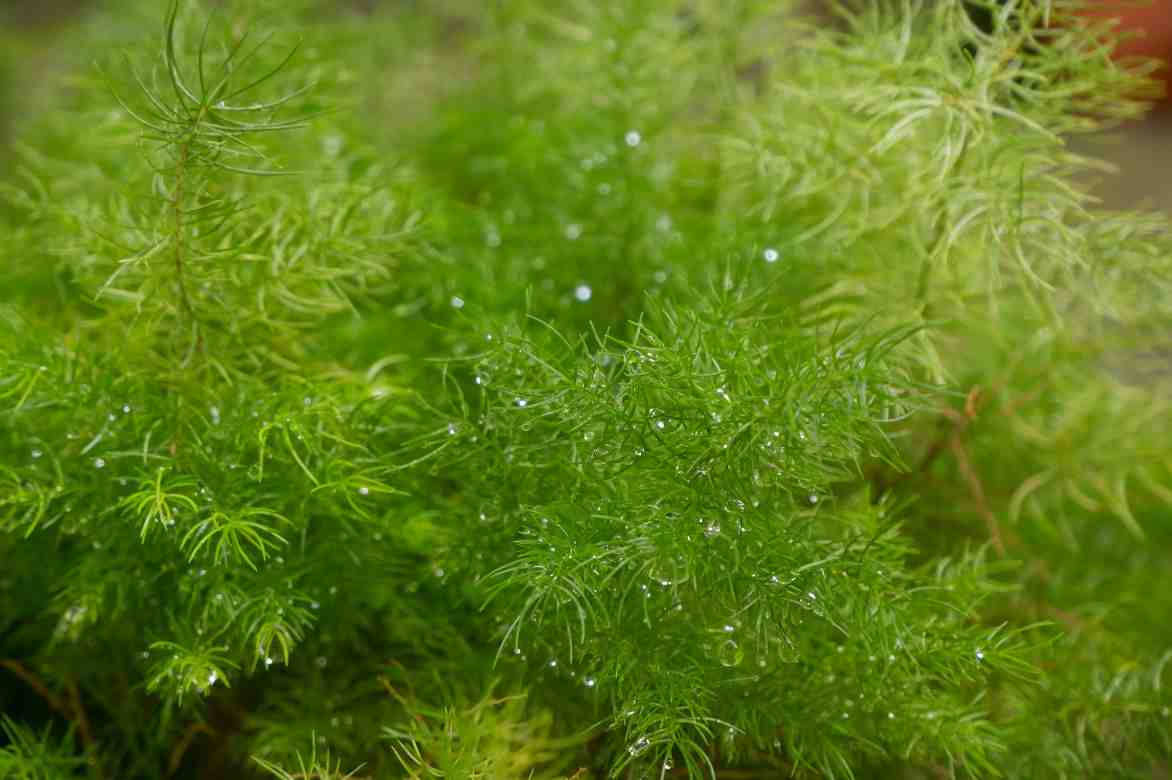
Asparagus setaceus
Potential Pests and Diseases in Indoor Asparagus
Asparagus is a robust and relatively hardy plant, but it can still fall victim to a few parasitic pests and diseases, especially indoors where dry air and poor air circulation encourage certain problems.
The most common parasitic pests
-
Spider mites: these tiny mites appear mainly when the air is too dry. They cause yellowing of the foliage and the formation of fine webs under the stems. To avoid them, it is essential to increase ambient humidity by misting the foliage with water or placing a container of water nearby. In case of infestation, wiping the leaves with a damp cloth and spraying with soapy water can be effective.
-
Mealybugs: they form small cottony clusters at the base of the stems or under the cladodes. These pests suck the sap and weaken the plant. To eliminate them, use a cotton swab dipped in 70% alcohol or apply a natural treatment of diluted black soap in water.
-
Aphids: less common, they sometimes settle on new shoots. They can be removed with a strong jet of water or a mixture of water and black soap.
-
Thrips: these tiny insects leave silvery spots on the leaves and weaken the plant. A simple daily spray of non-calcareous water can help get rid of them.
Possible diseases
-
Root rot: this is the most common problem, usually caused by overwatering or poor substrate drainage. The tuberous roots rot, and the plant quickly deteriorates. To avoid this, water moderately and ensure the pot has drainage holes. If the roots are affected, repot the Asparagus in dry substrate after cutting away the rotten parts.
-
Leaf spots and yellowing: brown or yellow spots may appear if the plant is exposed to too much direct sunlight, if the air is too dry, or if it suffers from a lack of nutrients. Balanced fertilisation and good management of ambient humidity can help limit this issue.
-
Mould and fungi: excess moisture and poor air circulation can encourage mould growth on the substrate or stems. If this happens, reduce watering and ventilate the room to improve the plant’s environment.
Prevention and good practices
- Ventilate the room regularly to avoid diseases related to stagnant moisture.
- Check the foliage and the base of the stems occasionally to spot pests as soon as they appear.
- Avoid overwatering and use a well-draining substrate to prevent root rot.
- Clean the foliage with a damp cloth occasionally to remove dust and limit pest attacks.
How to propagate Asparagus?
Asparagus can be propagated in two main ways: by dividing the tuberous roots and by sowing. Division is the simplest and quickest method, while sowing requires more patience.
Dividing the clumps (the easiest and quickest method)
Division is the ideal technique for propagating an Asparagus while rejuvenating a plant that has become too dense in its pot. It is best done in spring, during repotting, when the plant resumes its growth.
Steps to follow:
- Remove the plant from the pot: gently take the Asparagus out of its pot by tapping the sides to free the roots without damaging them.
- Separate the clumps: using your hands or a sharp knife, divide the root ball into several sections. Each section should contain tuberous roots and several healthy stems.
- Repot each section: place each division in a new pot with a fresh, light, and well-draining substrate.
- Water lightly: moderate watering will help the plant settle in without risking root rot.
The new plants will quickly resume their growth and develop beautiful foliage within a few weeks.
Sowing (a long and delicate method)
Propagation by sowing is possible if the Asparagus has produced red or black berries, which contain seeds. This method takes more time, as the seeds take several weeks to germinate, and the plant will take several months, or even years, to reach a good size.
How to sow Asparagus?
- Harvest the seeds: once the berries are ripe (red or black), collect the seeds by cleaning them thoroughly under water.
- Soak the seeds: let them soak for 24 hours in lukewarm water to soften their coat and facilitate germination.
- Prepare the substrate: use a mixture of light and sandy compost to ensure good drainage.
- Sow on the surface: place the seeds on the surface of the compost and cover them with a thin layer of substrate.
- Maintain moisture and warmth: water lightly and place the pot in a warm (20-25°C) and bright spot, out of direct sunlight. Covering the pot with plastic film or a mini greenhouse helps retain moisture.
- Patience! Germination may take 3 to 6 weeks, sometimes longer. Once the seedlings are well developed, they can be transplanted individually.
Indoor Asparagus: Where and How to Showcase It?
With its airy and delicate foliage, the Asparagus adapts to many interior styles, adding an elegant and light touch of nature. It is particularly suited to boho, Scandinavian, tropical, and vintage atmospheres, but it can also blend into more modern décors thanks to its graphic appeal.
Where to place it for a beautiful display?
- High up or suspended: trailing varieties like Asparagus sprengeri look stunning in hanging baskets or on wall shelves, where their foliage can cascade freely.
- On a piece of furniture or a bright windowsill: Asparagus plumosus, with its gracefully arched stems, will find its place on a console, dresser, or bookshelf, adding a touch of greenery without overwhelming the space.
- In an open terrarium: its fine and light appearance makes it an excellent candidate for an open terrarium, where it can coexist with other tropical plants like fittonias and mosses.
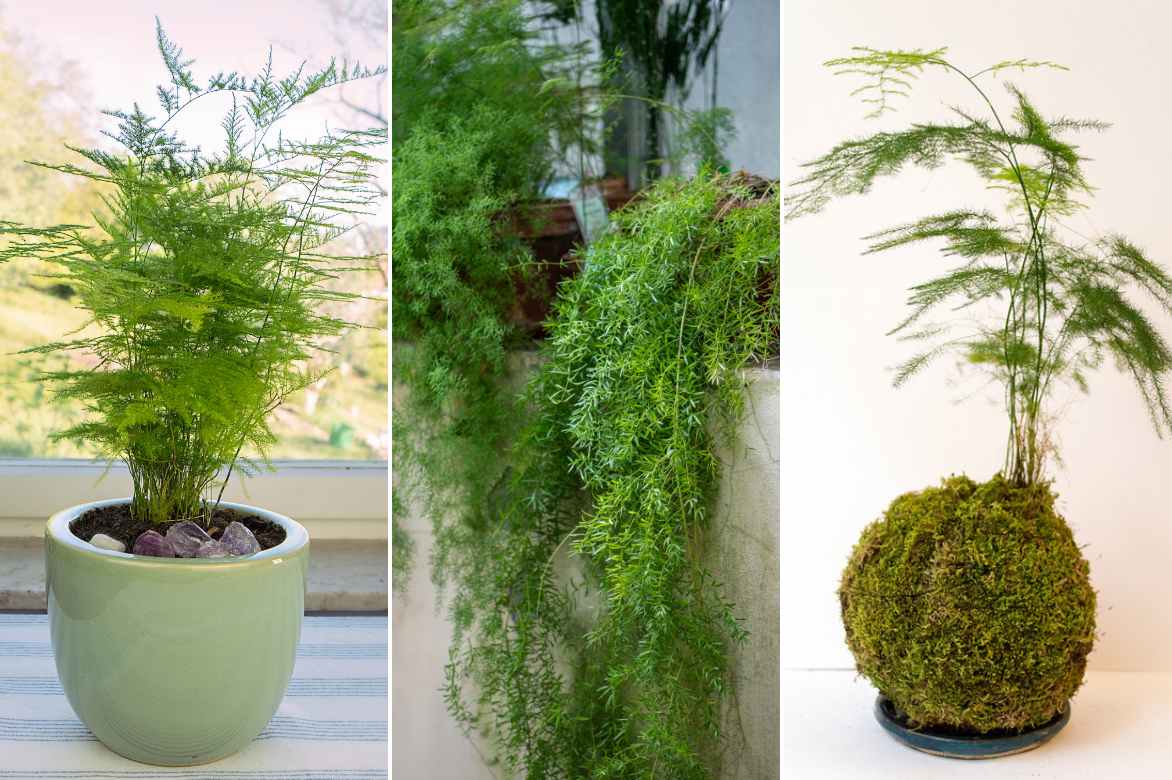
Asparagus setaceus, Asparagus sprengeri, and kokedama of Asparagus plumosus (© Gergerly Hideg)
Which pot to choose to enhance it?
- A raw terracotta pot: perfect for a boho, rustic, or Mediterranean style. It also has the advantage of promoting good drainage.
- A ceramic pot in neutral tones (white, beige, light grey): ideal for a Scandinavian or minimalist interior, highlighting the delicate texture of its foliage.
- A wicker or rattan planter: perfect for a natural and cosy atmosphere.
- A macramé hanging pot: enhances the airy quality of the Asparagus, especially for trailing varieties.
- A glass terrarium: for a more contemporary or urban jungle look, Asparagus plumosus can be grown in a large open terrarium, where its fine foliage will create a magical effect.
Also see
→ Discover our wide range of houseplants.
- Subscribe!
- Contents
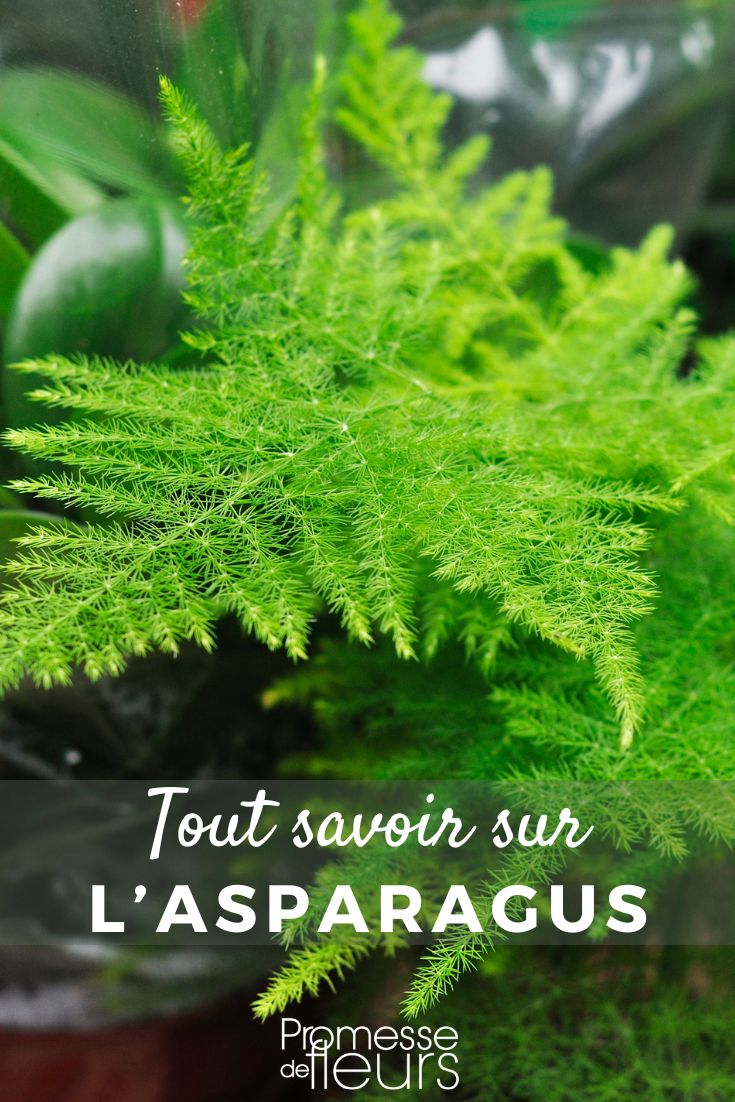































Comments